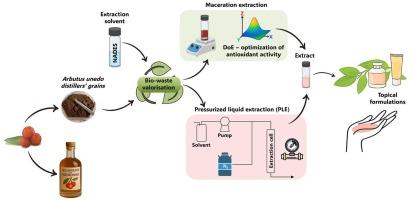杨梅蒸馏器谷物局部应用的增值:通过常规和加压技术提取NADES
IF 9
1区 工程技术
Q1 ENGINEERING, CHEMICAL
引用次数: 0
摘要
在生产杨梅(A. unedo)烈酒的过程中,会产生大量的酒糟。这些副产品富含酚类化合物(PCs),这是一种以抗氧化活性而闻名的分子家族。本研究通过提取生物活性化合物来生产富含抗氧化剂的提取物,以直接纳入化妆品配方,研究了这种废物流的增值。以天然深共晶溶剂(NADES)为萃取剂,采用浸渍法和加压液体萃取法(PLE)进行萃取。对所得提取物的总酚含量(TPC)、总黄酮含量(TFC)和抗氧化活性(AA)进行了评价。筛选实验表明,NADES的性能优于传统溶剂(水和乙醇水溶液),其中脯氨酸:丙二醇(1:4)含65 mol%水的效果最好。采用响应面法(RSM),通过不同浸提温度、NADES比和含水量对AA浸渍效果进行优化。以脯氨酸摩尔分数为0.41,14 mol%的水为脯氨酸摩尔分数,提取温度为58 ℃,提取时间为30 min,得到AA最高的提取液。与优化的浸渍结果相比,PLE进一步提高了AA,使用Pro:PPG(1:4), 65 mol%的水,75 °C, 1500 psi,两次提取周期,每次15 min。将优化后的浸渍提取液和PLE提取液分别加入化妆品配方中,并对其流变性能进行了表征。这项工作代表了第一个研究,探索在化妆品中使用unedo酒糟提取物。本文章由计算机程序翻译,如有差异,请以英文原文为准。

Valorisation of Arbutus unedo distillers' grains for topical applications: NADES extraction via conventional and pressurized techniques
During the production of Arbutus unedo (A. unedo) spirit, large quantities of distillers' grains are generated. These by-products are rich in phenolic compounds (PCs), a family of molecules well known for their antioxidant activity. This study investigates the valorisation of this waste stream by extracting bioactive compounds to produce antioxidant rich extracts for direct incorporation into cosmetic formulations.Maceration and pressurized liquid extraction (PLE) were selected as extraction techniques, using natural deep eutectic solvents (NADES) as extractants. The obtained extracts were evaluated for total phenolic content (TPC), total flavonoid content (TFC), and antioxidant activity (AA). Screening experiments revealed that NADES outperformed conventional solvents (water and aqueous ethanol mixtures), with Proline:Propylene Glycol (1:4) containing 65 mol% water yielding the best results. Response surface methodology (RSM) was then applied to optimize AA in maceration by varying extraction temperature, NADES ratio, and water content. The extract with the highest AA was obtained using Pro:PPG with a proline molar fraction of 0.41, 14 mol% water, at 58 °C, and 30 min extraction time. PLE further improved AA compared to the optimized maceration results, using Pro:PPG (1:4) with 65 mol% water at 75 °C, 1500 psi, and two extraction cycles of 15 min each.The optimized extracts from both maceration and PLE were incorporated into cosmetic formulations, and their rheological properties were characterized. This work represents the first study to explore the use of A. unedo distillers' grain extracts in cosmetics.
求助全文
通过发布文献求助,成功后即可免费获取论文全文。
去求助
来源期刊

Separation and Purification Technology
工程技术-工程:化工
CiteScore
14.00
自引率
12.80%
发文量
2347
审稿时长
43 days
期刊介绍:
Separation and Purification Technology is a premier journal committed to sharing innovative methods for separation and purification in chemical and environmental engineering, encompassing both homogeneous solutions and heterogeneous mixtures. Our scope includes the separation and/or purification of liquids, vapors, and gases, as well as carbon capture and separation techniques. However, it's important to note that methods solely intended for analytical purposes are not within the scope of the journal. Additionally, disciplines such as soil science, polymer science, and metallurgy fall outside the purview of Separation and Purification Technology. Join us in advancing the field of separation and purification methods for sustainable solutions in chemical and environmental engineering.
 求助内容:
求助内容: 应助结果提醒方式:
应助结果提醒方式:


